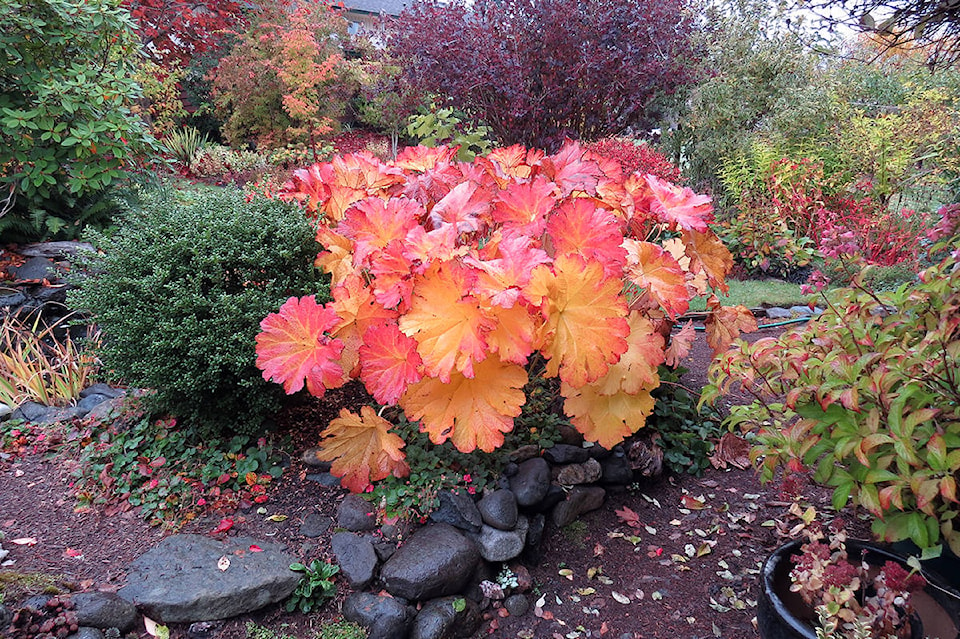By Leslie Cox
Special to The Record
Talk about colour punch!
My elevated view of the back garden from the kitchen and dining room is a symphony of warm colours in shades of yellow, gold, orange, red, rust, and burgundy. The whole scene is a breath-catching assault on the visual. A glorious start to the day.
On sunny days, that is. Not quite so much on rainy, grey days. But still, there are a few plants in the garden which provide a punch of colour in all but the greyest of grey days. Like Darmera peltata, the umbrella plant. Appropriately named for our current weather pattern, don’t you think?
Imagine, if you will, large, round, scallop-edged leaves in a soothing medium green colour that stretch almost 24 inches across. If this is not enough to grab your attention, air-brush shades of burgundy, red, orange, and yellow, in that order, around the scalloped edges, slowly increasing their bands until the yellow has overtaken the original green in the centre of the leaves as the autumn days progress.
There is no other word for it. Wow!
And to think this spectacular display all started back in April with the emergence of the most innocuous-looking plant buds you can imagine. In truth, this plant’s wake-up from hibernation starts with the flower buds popping up first. The term for this phenomenon is “precocious.” (Seriously, I am not making this up.)
The initial spring vision of Darmera peltata is a bed of hairy, pinkish stalks reaching a height of 24 inches…all individually topped with a rounded cluster of pinkish-white, five-petalled flowers. The leaves will not begin to appear until sometime in May. A very strange landscape indeed.
However, once those leaves break open, the vision is pure awesomeness. Three to five feet in height, Darmera peltata is truly an eye-catching focal point in the garden. Especially if you have allowed it some room to spread out from its rhizomatous roots.
I was surprised to learn this plant is classified as a wildflower of the Pacific Northwest. Unfortunately, it is officially noted as rare in its native regions in southwestern Oregon and northwestern California.
Lucky for us, it is perfectly hardy to our region and available in some nurseries. In fact, this plant species has earned the prestigious Award of Garden Merit from the Royal Horticultural Society in England (bestowed in 1993). It was also selected as a Great Plant Pick in 2008 by the evaluating committee at the Elizabeth C. Miller Botanical Garden, located on the Olympic Peninsula in Washington State.
A double vote of approval for adding this plant to your landscape.
One downside - this plant prefers moist soil conditions. A placement next to a pond or in a bog area is ideal. If you place it in a drier location in full sun, be sure to water the plant regularly to avoid the leaf edges getting scorched.
Feeling left out because you only have a small garden? Don’t. There is a dwarf version of the umbrella plant called Darmera peltata ‘Nana’. It only gets about two feet tall and two feet wide (60 cm x 60 cm). It, too, was selected as a Great Plant Pick in 2008…a wonderful endorsement for inclusion in your small landscape.
***
I do love to hear from readers, and was especially thankful to receive an email from Irene after my last column, Harvesting for Health, appeared on Oct. 12. She kindly set me straight on the matter of Vitamin K. There are two kinds. Vitamin K1 promotes blood clotting proteins. Vitamin K2 is the one I should have stipulated as it promotes healthy bones.
Leslie Cox co-owns Growing Concern Cottage Garden in Black Creek. Her website is at www.duchessofdirt.ca and her column appears every second Thursday in the Record.
